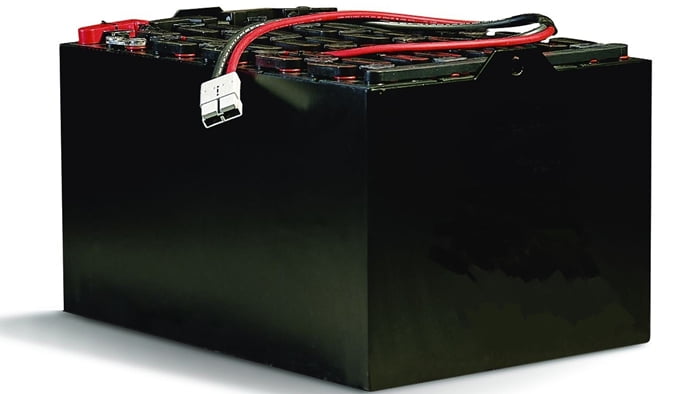Chapter 6: Battery and Charging Systems
Lift truck batteries come in all shapes and sizes. A typical battery’s dimensions and weight can vary widely depending on the truck, but in the case of the 5,000 lb. electric sit-down counterbalanced lift truck, it’s approximately 40 inches wide by 32 inches high by 34 inches front-to-back, and it weighs around 3,200 lbs. A lift truck battery must continually provide power for vehicle systems (the three main system motors – drive, steering and load-lift), so its physical size and energy capacity must be large. Also, the heavy battery in a lift truck contributes a substantial amount of the truck’s counterweight.
How often a battery charge or change-out becomes necessary on an electric lift truck depends on how it is used. In a three-shift operation, a battery will definitely need to be changed out during the three shifts of work – physically removed and replaced by a fully-charged one. With the lead-acid battery technology present in today’s lift trucks, if the energy in the battery becomes depleted, it takes a long time to put the energy back into it correctly. In fact, it’s common in the material handling industry to refer to the “8-8-8 rule,” which means that it takes about 8 hours to deplete a battery working on the job, 8 hours to charge it back up and another 8 hours to allow the battery to sufficiently cool. New and emergent battery technologies are shortening the 8-8-8 rule times. For example, new high-frequency (HF) ‘fast-charging’ technology allows multi-shift operations to charge batteries partially during breaks in a shift, and then at lunch or at shift’s-end to fully charge it up in approximately an hour and a half. However, although this ‘fast-charging’ technology represents a significant improvement, there’s a limit in how far this technology can be taken. For example, ‘fast charging’ technology still requires a weekly “equalizing charge.”
Read The Full Series:
Chapter 1: The Concept of Total Cost of Ownership (TCO)
Chapter 2: AC Technology Compared to Internal Combustion
Chapter 3: Compressed Natural Gas (CNG)
Chapter 4: Trends in Materials Handling
Chapter 5: Voltage Levels Used in Electric Lift trucks Today
Chapter 6: Battery and Charging Systems
Chapter 7: Electric Braking and Energy Regeneration
Chapter 8: Emissions and Corporate Responsibility: A Major Problem for IC Lift Trucks
HCO Innovations is publishing this eight-part series as an in-depth comparative analysis and discussion on Compressed Natural Gas (CNG) Internal Combustion (IC) motors and Alternating Current (AC) Eletric lift truck engines, Comparison Analysis of CNG (IC) vs. AC Electric Lift Trucks, by Will Van Ness, VP of Fleet Management at HCO Innovations.
Comparison Analysis of CNG (IC) vs. AC Electric Lift Trucks (AC)
The materials handling industry continues to evolve at a rapid pace, particularly in the area of motive power propulsion. Tremendous technological advancements have been made over the past decade to directly address the rising cost of petrol (fossil fuels) along with stricter emission standards. Today’s MHE acquirers have more choices than ever when it comes to motive power propulsion and with the success seen amongst fleets utilizing alternative fuel sources such as lithium ion (LION) and Hydrogen Fuel Cell (HFC), the choices will most likely increase as time goes on. For the purpose of this discussion document, our focus will be on comparing AC Electric (AC) to Internal Combustion powered lift trucks (IC), specifically compressed natural gas (CNG).

